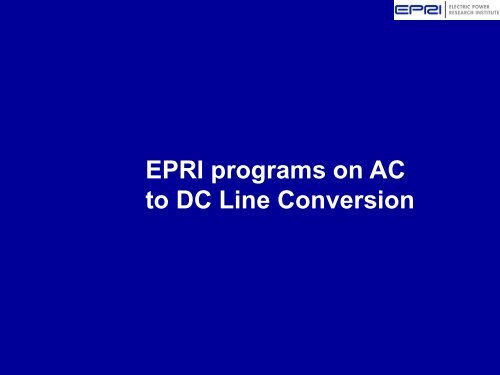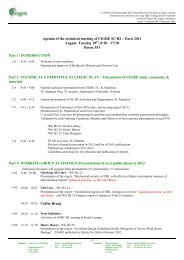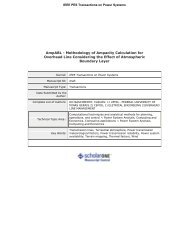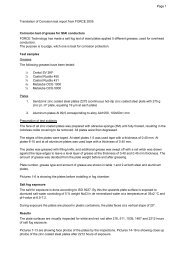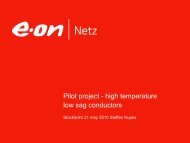EPRI programs on AC to DC Line Conversion
EPRI programs on AC to DC Line Conversion
EPRI programs on AC to DC Line Conversion
Create successful ePaper yourself
Turn your PDF publications into a flip-book with our unique Google optimized e-Paper software.
C<strong>on</strong>versi<strong>on</strong> of <strong>AC</strong> <strong>Line</strong>s <strong>to</strong> HV<strong>DC</strong><br />
<str<strong>on</strong>g>EPRI</str<strong>on</strong>g> <str<strong>on</strong>g>programs</str<strong>on</strong>g> <strong>on</strong> <strong>AC</strong><br />
<strong>to</strong> <strong>DC</strong> <strong>Line</strong> C<strong>on</strong>versi<strong>on</strong><br />
• <strong>DC</strong> Voltage Sustainable by the<br />
c<strong>on</strong>verted circuit<br />
• Step-up in Current attainable<br />
with <strong>DC</strong><br />
• <strong>DC</strong> C<strong>on</strong>figurati<strong>on</strong><br />
• Effect <strong>on</strong> loading of parallel <strong>AC</strong>
Two approaches:<br />
1. Adapt ac <strong>to</strong>wers <strong>to</strong> bipole dc<br />
2. Adapt bipole dc <strong>to</strong> three phase positi<strong>on</strong>s<br />
Focus of <str<strong>on</strong>g>EPRI</str<strong>on</strong>g><br />
studies
<str<strong>on</strong>g>EPRI</str<strong>on</strong>g> <strong>AC</strong> <strong>to</strong> <strong>DC</strong> c<strong>on</strong>versi<strong>on</strong> studies:<br />
1. Role of Bidirecti<strong>on</strong>al Valves (2005-2006)<br />
2. Methods for Assessing the <strong>DC</strong> Capability of <strong>AC</strong><br />
transmissi<strong>on</strong> lines (2005-2008)<br />
“<strong>DC</strong> C<strong>on</strong>vert Software”<br />
3. <strong>DC</strong> capability of example ac line designs 138 kV<br />
<strong>to</strong> 765 kV (2008-2009)<br />
4. C<strong>on</strong>solidated Report (2009-2010)
C<strong>on</strong>versi<strong>on</strong> of <strong>AC</strong> <strong>Line</strong>s <strong>to</strong> HV<strong>DC</strong><br />
Ec<strong>on</strong>omic viability of<br />
c<strong>on</strong>versi<strong>on</strong> depends<br />
<strong>on</strong> a high boost in MW<br />
rating
C<strong>on</strong>versi<strong>on</strong> means buying c<strong>on</strong>verter capacity for the<br />
original ac MW as well as any incremental gain in MW<br />
Regi<strong>on</strong> where high c<strong>on</strong>verter<br />
cost per incremental kW may<br />
be off set by avoided<br />
c<strong>on</strong>structi<strong>on</strong> of new circuits
MW gain by c<strong>on</strong>versi<strong>on</strong> is due <strong>to</strong>:<br />
• Higher MW capability for equal current limits<br />
• Ability <strong>to</strong> c<strong>on</strong>trol flow<br />
• <strong>DC</strong>’s redundancy<br />
• High momentary overload capability<br />
• Var supply capability (VSC schemes)<br />
Gain in specific cases depends <strong>on</strong>:<br />
- Prior ac loading limit<br />
- Allowable dc Voltage<br />
- <strong>DC</strong> C<strong>on</strong>figurati<strong>on</strong><br />
- Effect of dc operati<strong>on</strong> <strong>on</strong> parallel ac loading
C<strong>on</strong>versi<strong>on</strong> of <strong>AC</strong> <strong>Line</strong>s <strong>to</strong> HV<strong>DC</strong><br />
Bipole C<strong>on</strong>versi<strong>on</strong><br />
Alternative<br />
• <strong>DC</strong> Voltage Sustainable by the<br />
c<strong>on</strong>verted circuit<br />
• Step-up in Current attainable<br />
with <strong>DC</strong><br />
• <strong>DC</strong> C<strong>on</strong>figurati<strong>on</strong><br />
• Effect <strong>on</strong> loading of parallel <strong>AC</strong>
MW gain for bipole with metallic return?<br />
A<br />
B<br />
C<br />
+ A<br />
B<br />
C<br />
Let:<br />
k =<br />
pf = ac power fac<strong>to</strong>r<br />
r ac =<br />
Then:<br />
Pbipole =<br />
Pac 2k√2 1<br />
3pf rac x<br />
For k=1, pf = 1, rac =70%<br />
Pbipole = 1.18<br />
P ac<br />
V dc<br />
2V ac l-g crest<br />
MW ac actual<br />
MW maximum
Ec<strong>on</strong>omic feasibility sensitive <strong>to</strong> MW gain
C<strong>on</strong>versi<strong>on</strong> of <strong>AC</strong> <strong>Line</strong>s <strong>to</strong> HV<strong>DC</strong><br />
Tripole C<strong>on</strong>versi<strong>on</strong><br />
Alternative<br />
• <strong>DC</strong> Voltage Sustainable by the<br />
c<strong>on</strong>verted circuit<br />
• Step-up in Current attainable<br />
with <strong>DC</strong><br />
• <strong>DC</strong> C<strong>on</strong>figurati<strong>on</strong><br />
• Effect <strong>on</strong> loading of parallel <strong>AC</strong>
Pole 3 alternately relieves some pole 1<br />
current…then pole 2 current<br />
.37<br />
-1.37<br />
1.00<br />
1.37*<br />
-.37<br />
-1.00<br />
* .5 + √3/2
Thermal Averaging<br />
RMS (Heating) Current is<br />
(.37 2 + 1.37 2 )/2 = 1.00<br />
RMS (Heating) Current is<br />
(1 2 + 1 2 )/2 = 1.00<br />
Full use is made of thermal capacity of all<br />
phase positi<strong>on</strong>s
Tripole Power Capability<br />
At any given time, P dc = .37 +1.37 + 1 = 2.74<br />
Compared <strong>to</strong> 1 +1 = 2 for Bipole….1.37 times greater
Easy <strong>to</strong> create time for polarity reversal <strong>on</strong><br />
pole 3
Tripole Terminal Requirements:<br />
• All equipment is standard<br />
• Double the number of valve groups since pole<br />
three requires both + and – valves<br />
• Current rating of valves and cooling systems<br />
must be 1.37 higher than bipole for the same rms<br />
current. *<br />
• Transformer rating are unaffected by current<br />
modulati<strong>on</strong><br />
* Not a cost premium where a high<br />
emergency power rating is the objective.
MW gain for Tripole without metallic<br />
return?<br />
A<br />
B<br />
C<br />
P tripole<br />
P ac<br />
= 2x 1.37k√2<br />
1<br />
For k=1, pf = 1, r=70% :<br />
P tripole<br />
P ac<br />
3pf<br />
= 1.62<br />
x<br />
r ac
Ec<strong>on</strong>omic feasibility sensitive <strong>to</strong> MW gain
VSC’s will work with bipole or tripole opti<strong>on</strong>s
Comparis<strong>on</strong> of line losses<br />
If dc is operating at ac l-g crest voltage, then for equal<br />
transmitted power:<br />
Bipole with metallic return<br />
Tripole<br />
Split return operati<strong>on</strong><br />
+ Characterizes:<br />
L<br />
tripole =<br />
L<br />
ac<br />
. 6 p<br />
• Bipole where metallic return is forfeited<br />
2<br />
PU of bipole<br />
1.00<br />
• Tripole… up <strong>to</strong> 93% of maximum capacity<br />
0.80<br />
0.75
Total Losses – 230 Kv example<br />
Total Losses - %<br />
10%<br />
9%<br />
8%<br />
7%<br />
6%<br />
5%<br />
4%<br />
3%<br />
2%<br />
1%<br />
0%<br />
Voltage 230 kV<br />
Impedance .08 +j.7 ohms/mile<br />
C<strong>on</strong>duc<strong>to</strong>r 1,272 kcmil<br />
Max I (90 o C) 1,000 amperes<br />
Op. Rating 220 MVA<br />
200 Miles<br />
<strong>AC</strong><br />
Bipole<br />
Tripole<br />
0 50 100 150 200 250 300 350 400 450 500 550 600<br />
Real Power Transfer - MW
Redundancy<br />
Redundancy =<br />
Important because:<br />
Max. MW with <strong>on</strong>e pole out<br />
Total maximum MW<br />
• Need for earth return, ground electrodes can be eliminated<br />
• Redundancy prevents the c<strong>on</strong>verted line from becoming a limiting<br />
outage case where a large boost in MW capacity is realized.
Redundancy<br />
Or…assuming 15%<br />
emergency overload<br />
capability:<br />
dc<br />
ac<br />
m<strong>on</strong>opole<br />
bipole<br />
tripole<br />
Earth return No earth return<br />
0% 0%<br />
0% 0%<br />
57% 0%<br />
84% 84%
Emergency/Normal Capability<br />
P ac = Normal ac loading P’ ac = Emergency ac loading<br />
Emergency pick-up capability<br />
of the line <strong>to</strong> be c<strong>on</strong>verted<br />
Increase in parallel<br />
ac system loading:<br />
Increase in flow <strong>on</strong> the<br />
c<strong>on</strong>verted line itself:<br />
Before C<strong>on</strong>versi<strong>on</strong><br />
ΔP ac = P’ ac –P ac<br />
ΔMW ac = ΔP dc - ΔP ac<br />
ΔMW c<strong>on</strong>v. line = P dc -P ac<br />
ΔMW path = ΔMW ac + ΔMW c<strong>on</strong>v. line = P’ dc – P’ ac<br />
After C<strong>on</strong>versi<strong>on</strong><br />
ΔP dc = P’ dc –P dc
C<strong>on</strong>versi<strong>on</strong> of <strong>AC</strong> <strong>Line</strong>s <strong>to</strong> HV<strong>DC</strong><br />
<strong>DC</strong> Voltage sustainable<br />
by former circuits…<br />
The lower of:<br />
1. C<strong>on</strong>duc<strong>to</strong>r gradient limit (A/N)*<br />
• <strong>DC</strong> Voltage Sustainable by the<br />
c<strong>on</strong>verted circuit<br />
2. Insulati<strong>on</strong> limit (Polluti<strong>on</strong>)<br />
3. Clearance limit<br />
• Step-up in Current attainable<br />
with <strong>DC</strong><br />
4. Ground-level electric field limit*<br />
• <strong>DC</strong> C<strong>on</strong>figurati<strong>on</strong><br />
* Limits differ for different dc regimes<br />
• Effect <strong>on</strong> loading of parallel <strong>AC</strong>
C<strong>on</strong>versi<strong>on</strong> of <strong>AC</strong> <strong>Line</strong>s <strong>to</strong> HV<strong>DC</strong><br />
1. C<strong>on</strong>duc<strong>to</strong>r<br />
Gradient limits<br />
2. Earth surface<br />
gradient limits<br />
• <strong>DC</strong> Voltage Sustainable by the<br />
c<strong>on</strong>verted circuit<br />
• Step-up in Current attainable<br />
with <strong>DC</strong><br />
• <strong>DC</strong> C<strong>on</strong>figurati<strong>on</strong><br />
• Effect <strong>on</strong> loading of parallel <strong>AC</strong>
Voltage between phase positi<strong>on</strong>s<br />
<strong>AC</strong><br />
√3V ac-lg crest<br />
V ac-lg crest<br />
0<br />
Bipole<br />
2V ac-lg crest<br />
+/<br />
Tripole<br />
+<br />
+
Example Gradient Precedents:<br />
Example criteria:<br />
Reduced criteri<strong>on</strong> at lower voltages because of prior in-service ac<br />
precedent
Example earth-level field profile
C<strong>on</strong>versi<strong>on</strong> of <strong>AC</strong> <strong>Line</strong>s <strong>to</strong> HV<strong>DC</strong><br />
2. Insulati<strong>on</strong> limit<br />
3. Clearance limit<br />
• <strong>DC</strong> Voltage Sustainable by the<br />
c<strong>on</strong>verted circuit<br />
• Step-up in Current attainable<br />
with <strong>DC</strong><br />
• <strong>DC</strong> C<strong>on</strong>figurati<strong>on</strong><br />
Joint<br />
soluti<strong>on</strong><br />
• Effect <strong>on</strong> loading of parallel <strong>AC</strong>
Insulati<strong>on</strong> for HV<strong>DC</strong>:<br />
• Assume ac insula<strong>to</strong>rs replaced by dc units<br />
• Creepage distance criteria:<br />
• Need <strong>to</strong> add insula<strong>to</strong>rs <strong>to</strong> raise voltage?
<strong>AC</strong> Operati<strong>on</strong><br />
D e = Electrical<br />
comp<strong>on</strong>ent of<br />
clearance<br />
D f = Fixed comp<strong>on</strong>ent<br />
of clearance<br />
Min. c<strong>on</strong>duc<strong>to</strong>r height<br />
D e depends <strong>on</strong> the<br />
product S x V where V<br />
is crest line-<strong>to</strong>-ground<br />
voltage (ac or dc) and<br />
S is the overvoltage<br />
assumpti<strong>on</strong><br />
<strong>DC</strong> Operati<strong>on</strong><br />
Electrical comp<strong>on</strong>ent of<br />
clearance<br />
Fixed comp<strong>on</strong>ent of<br />
clearance<br />
Room for more<br />
insula<strong>to</strong>rs<br />
Min. c<strong>on</strong>duc<strong>to</strong>r height<br />
Lower S for dc reduces<br />
D e for the same l-g<br />
voltage.
Does extensi<strong>on</strong> jeopardize clearance <strong>to</strong><br />
<strong>to</strong>wer?<br />
• At 30 o swing, clearance reducti<strong>on</strong> <strong>to</strong> <strong>to</strong>wer is ½ clearance<br />
reducti<strong>on</strong> <strong>to</strong> ground…normally not limiting<br />
• Cauti<strong>on</strong> with l<strong>on</strong>g extensi<strong>on</strong>s and clearance <strong>to</strong> lower crossarms<br />
<strong>on</strong> vertical c<strong>on</strong>figurati<strong>on</strong>s
C<strong>on</strong>versi<strong>on</strong> of <strong>AC</strong> <strong>Line</strong>s <strong>to</strong> HV<strong>DC</strong><br />
Example studies<br />
• <strong>DC</strong> Voltage Sustainable by the<br />
c<strong>on</strong>verted circuit<br />
• Step-up in Current attainable<br />
with <strong>DC</strong><br />
• <strong>DC</strong> C<strong>on</strong>figurati<strong>on</strong><br />
• Effect <strong>on</strong> loading of parallel <strong>AC</strong>
Towers c<strong>on</strong>sidered:<br />
138 kV<br />
345 kV<br />
765 kV<br />
230 kV<br />
500 kV
C<strong>on</strong>clusi<strong>on</strong>s:<br />
1. V dc may be as high as 2xV l-g ac at lower voltages, less than<br />
V l-g ac 1.0 at the highest. V bipole will generally exceed V tripole<br />
2. C<strong>on</strong>duc<strong>to</strong>r gradient usually limits V dc for lower voltage;<br />
Earth field for highest voltages or lines with very large<br />
bundles<br />
Some Example Cases<br />
3. Tripole c<strong>on</strong>versi<strong>on</strong> gets larger MW gains than the bipole<br />
except when c<strong>on</strong>verting a double circuit ac line <strong>to</strong> all dc<br />
4. Where insulati<strong>on</strong> is limiting, there are work-arounds<br />
5. Bipole and tripole have different effests <strong>on</strong> allowable flow<br />
<strong>on</strong> parallel ac<br />
6. C<strong>on</strong>versi<strong>on</strong> can increase a circuit’s c<strong>on</strong>tributi<strong>on</strong> <strong>to</strong> path<br />
flow by as much as 2:1… the largest gains at the lowest<br />
transmissi<strong>on</strong> voltages.
C<strong>on</strong>versi<strong>on</strong> of <strong>AC</strong> <strong>Line</strong>s <strong>to</strong> HV<strong>DC</strong><br />
Is ac <strong>to</strong> dc c<strong>on</strong>versi<strong>on</strong><br />
ec<strong>on</strong>omically<br />
justified?<br />
• <strong>DC</strong> Voltage Sustainable by the<br />
c<strong>on</strong>verted circuit<br />
• Step-up in Current attainable<br />
with <strong>DC</strong><br />
• <strong>DC</strong> C<strong>on</strong>figurati<strong>on</strong><br />
• Effect <strong>on</strong> loading of parallel <strong>AC</strong>
Example costs for transmitting<br />
electric power
An estimate of l<strong>on</strong>g distance<br />
500 kV dc cable<br />
• $4 Milli<strong>on</strong> per mile<br />
• $200 per KW per terminal<br />
138 kV<br />
230 kV<br />
345 kV<br />
500<br />
765 kV<br />
500 kV UG
Cost <strong>to</strong> gain transfer by ac <strong>to</strong> dc c<strong>on</strong>versi<strong>on</strong>:<br />
• Including insula<strong>to</strong>r change-out<br />
• <strong>DC</strong>E = 1<br />
For example, if actual terminal cost is $200/kw per terminal but <strong>DC</strong>E is<br />
.8, effective cost <strong>on</strong> this curve would be $200/.8 =$250 per kW<br />
138 kV<br />
230 kV<br />
345 kV<br />
500<br />
765 kV<br />
500 kV UG
Points corresp<strong>on</strong>ding <strong>to</strong> an<br />
actual case<br />
138 kV<br />
230 kV<br />
345 kV<br />
500<br />
765 kV<br />
500 kV UG
C<strong>on</strong>versi<strong>on</strong> of <strong>AC</strong> <strong>Line</strong>s <strong>to</strong> HV<strong>DC</strong><br />
Current Industry<br />
Needs?<br />
• <strong>DC</strong> Voltage Sustainable by the<br />
c<strong>on</strong>verted circuit<br />
• Step-up in Current attainable<br />
with <strong>DC</strong><br />
• <strong>DC</strong> C<strong>on</strong>figurati<strong>on</strong><br />
• Effect <strong>on</strong> loading of parallel <strong>AC</strong>
Industry Needs?<br />
1. Dem<strong>on</strong>strati<strong>on</strong> projects<br />
2. Example studies which integrate system issue<br />
3. <strong>DC</strong> Voltage limitati<strong>on</strong>s of c<strong>on</strong>verted lines<br />
4. Better definiti<strong>on</strong> of ground-level field<br />
requirements<br />
5. Better definiti<strong>on</strong> of system influence <strong>on</strong> choice<br />
of c<strong>on</strong>versi<strong>on</strong> opti<strong>on</strong>


